Rui Campos
Joint Optimization of Multi-UAV Deployment and 3D Positioning in Traffic-Aware Aerial Networks
Jun 16, 2025Abstract:Unmanned Aerial Vehicles (UAVs) have emerged as a key enabler for next-generation wireless networks due to their on-demand deployment, high mobility, and ability to provide Line-of-Sight (LoS) connectivity. These features make UAVs particularly well-suited for dynamic and mission-critical applications such as intelligent transportation systems and emergency communications. However, effectively positioning multiple UAVs in real-time to meet non-uniform, time-varying traffic demands remains a significant challenge, especially when aiming to optimize network throughput and resource utilization. In this paper, we propose an Efficient Multi-UAV Traffic-Aware Deployment (EMTAD) Algorithm, a scalable and adaptive framework that dynamically adjusts UAV placements based on real-time user locations and spatial traffic distribution. In contrast to existing methods, EMTAD jointly optimizes UAV positioning and minimizes the number of deployed UAVs, ensuring efficient UE-UAV association while satisfying the traffic demand of users. Simulation results demonstrate that EMTAD significantly improves network performance while reducing deployment overhead by minimizing the number of UAVs required in dynamic and traffic-aware environments.
A Framework Leveraging Large Language Models for Autonomous UAV Control in Flying Networks
Jun 04, 2025Abstract:This paper proposes FLUC, a modular framework that integrates open-source Large Language Models (LLMs) with Unmanned Aerial Vehicle (UAV) autopilot systems to enable autonomous control in Flying Networks (FNs). FLUC translates high-level natural language commands into executable UAV mission code, bridging the gap between operator intent and UAV behaviour. FLUC is evaluated using three open-source LLMs - Qwen 2.5, Gemma 2, and LLaMA 3.2 - across scenarios involving code generation and mission planning. Results show that Qwen 2.5 excels in multi-step reasoning, Gemma 2 balances accuracy and latency, and LLaMA 3.2 offers faster responses with lower logical coherence. A case study on energy-aware UAV positioning confirms FLUC's ability to interpret structured prompts and autonomously execute domain-specific logic, showing its effectiveness in real-time, mission-driven control.
Traffic and Obstacle-aware UAV Positioning in Urban Environments Using Reinforcement Learning
Aug 07, 2024Abstract:Unmanned Aerial Vehicles (UAVs) are suited as cost-effective and adaptable platforms for carrying Wi-Fi Access Points (APs) and cellular Base Stations (BSs). Implementing aerial networks in disaster management scenarios and crowded areas can effectively enhance Quality of Service (QoS). In such environments, maintaining Line-of-Sight (LoS), especially at higher frequencies, is crucial for ensuring reliable communication networks with high capacity, particularly in environments with obstacles. The main contribution of this paper is a traffic- and obstacle-aware UAV positioning algorithm named Reinforcement Learning-based Traffic and Obstacle-aware Positioning Algorithm (RLTOPA), for such environments. RLTOPA determines the optimal position of the UAV by considering the positions of ground users, the coordinates of obstacles, and the traffic demands of users. This positioning aims to maximize QoS in terms of throughput by ensuring optimal LoS between ground users and the UAV. The network performance of the proposed solution, characterized in terms of mean delay and throughput, was evaluated using the ns- 3 simulator. The results show up to 95% improvement in aggregate throughput and 71% in delay without compromising fairness.
On the Energy Consumption of Rotary Wing and Fixed Wing UAVs in Flying Networks
Jun 27, 2024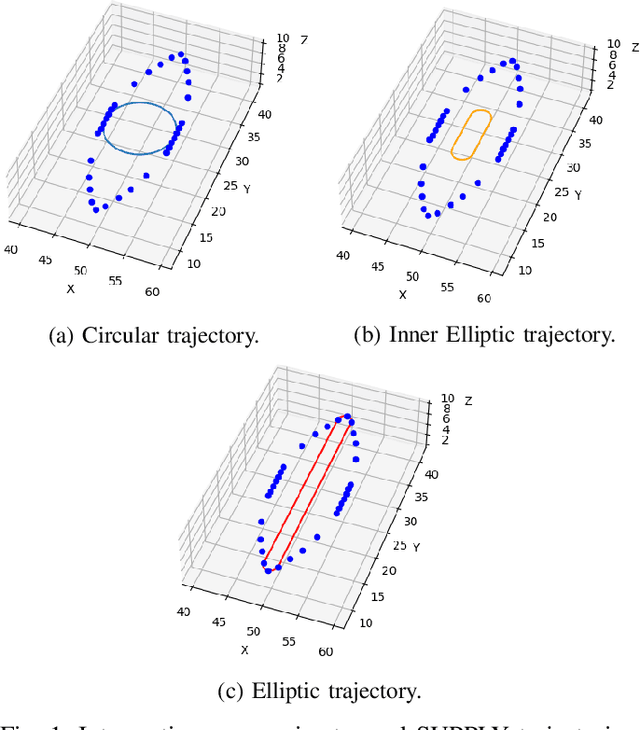
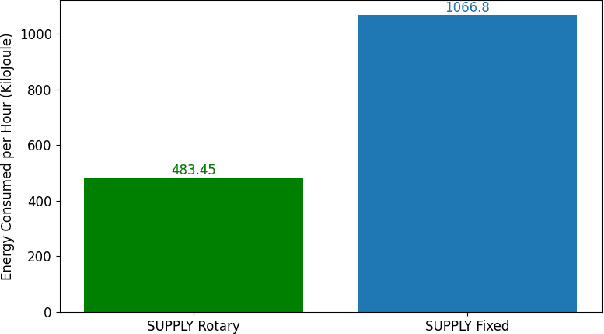
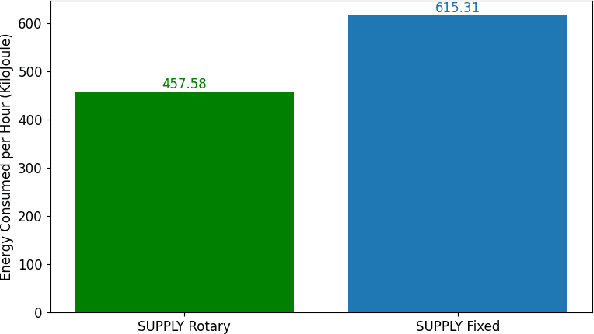
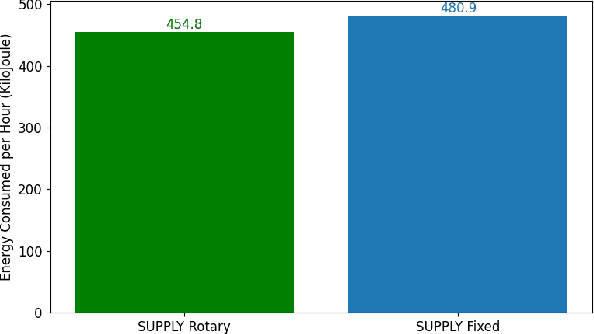
Abstract:Unmanned Aerial Vehicles (UAVs) are increasingly used to enable wireless communications. Due to their characteristics, such as the ability to hover and carry cargo, UAVs can serve as communications nodes, including Wi-Fi Access Points and Cellular Base Stations. In previous work, we proposed the Sustainable multi-UAV Performance-aware Placement (SUPPLY) algorithm, which focuses on the energy-efficient placement of multiple UAVs acting as Flying Access Points (FAPs). Additionally, we developed the Multi-UAV Energy Consumption (MUAVE) simulator to evaluate the UAV energy consumption, specifically when using the SUPPLY algorithm. However, MUAVE was initially designed to compute the energy consumption for rotary-wing UAVs only. In this paper, we propose eMUAVE, an enhanced version of the MUAVE simulator that allows the evaluation of the energy consumption for both rotary-wing and fixed-wing UAVs. Our energy consumption evaluation using eMUAVE considers reference and random networking scenarios. The results show that fixed-wing UAVs can be employed in the majority of networking scenarios. However, rotary-wing UAVs are typically more energy-efficient than fixed-wing UAVs when following the trajectories defined by SUPPLY.
Semantic Communications: the New Paradigm Behind Beyond 5G Technologies
Jun 02, 2024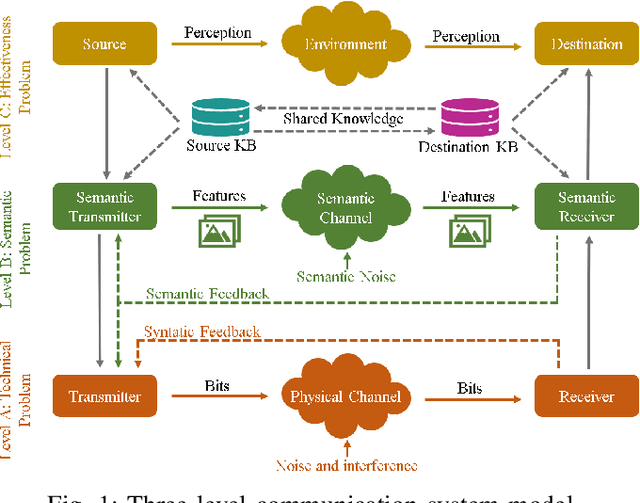
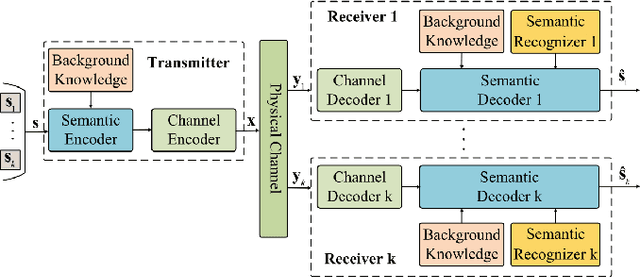
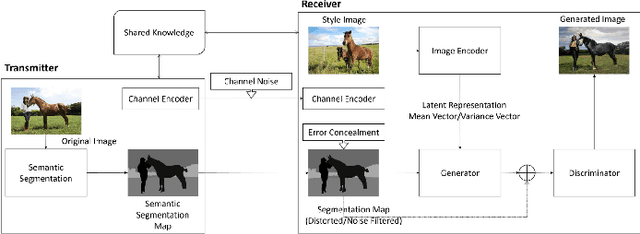
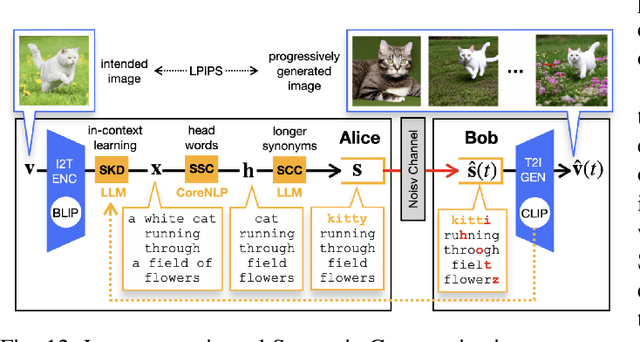
Abstract:Each generation of cellular networks is characterized by its distinct capabilities and innovations, which reflect the significant milestones reached with each new release. 5G has made substantial progress through the deployment of advanced encoding and modulation techniques, nearly reaching the Shannon physical capacity limit. In light of the requirements of Beyond-5G technologies, there is the need of a paradigm shift in the development of communication systems. Recent developments in the realm of Artificial Intelligence (AI) have enabled the deployment of tools with high abstraction capabilities, relevant for feature extraction processes and End-to-End system optimization tasks. In this context, Semantic Communications has emerged as a novel information transmission system, with AI as one of the core components in its implementation. This communication paradigm relies on the extraction and transmission of the "semantic meaning" of the source information using AI techniques, diverging from the conventional systems that primarily focus on ensuring the successful reception of the transmitted bits. The purpose of this survey is to provide a comprehensive overview of the fundamental concepts underlying Semantic Communications, including Shannon's Information Theory, classical and modern theories of semantic information, and an examination of the framework and system design of Semantic Communications. Additionally, recent implementations are reviwed, including the analysis of Semantic Communications systems according to the information object transmitted and the objective of the information transmission. Moreover, an in-depth study of prototypes and demonstrations are presented, supporting the viability of the Semantic Communications systems. Finally, some of the most relevant open challenges are detailed, highlighting open research questions to be pursued in Semantic Communications.
SUPPLY: Sustainable multi-UAV Performance-aware Placement Algorithm for Flying Networks
Apr 09, 2024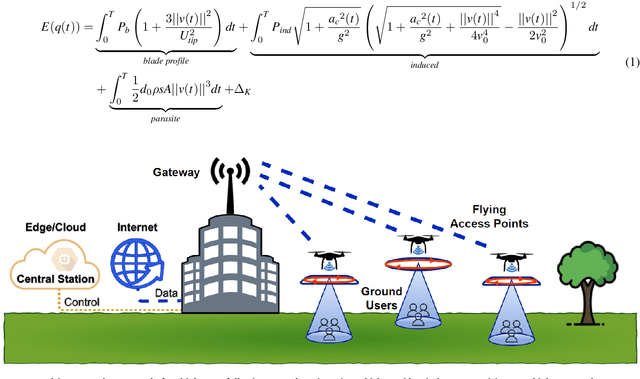
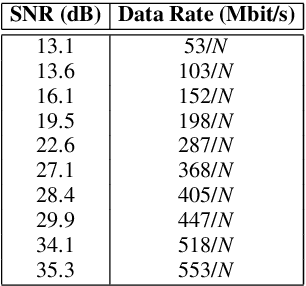
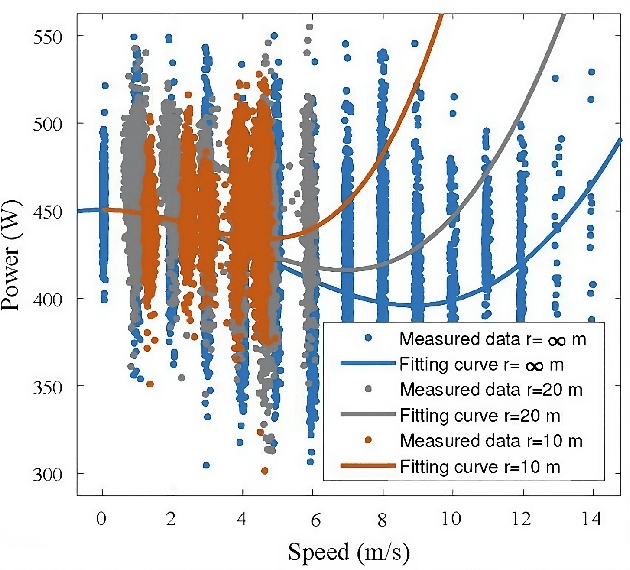
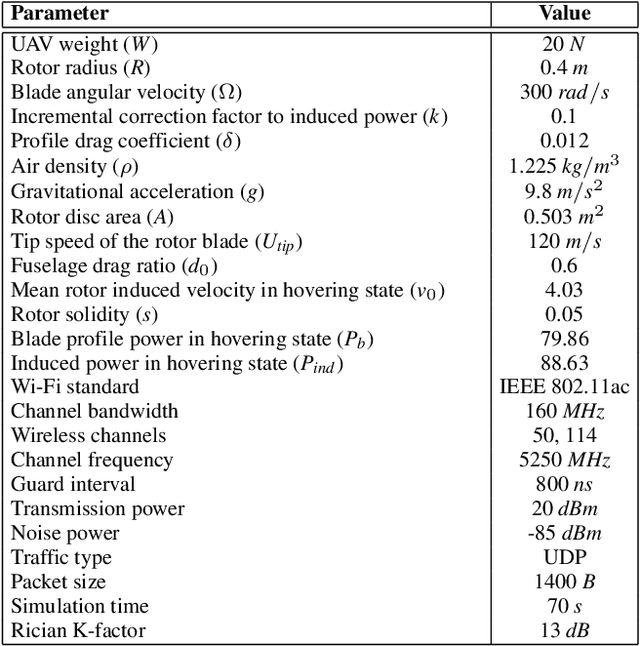
Abstract:Unmanned Aerial Vehicles (UAVs) are used for a wide range of applications. Due to characteristics such as the ability to hover and carry cargo on-board, rotary-wing UAVs have been considered suitable platforms for carrying communications nodes, including Wi-Fi Access Points and cellular Base Stations. This gave rise to the concept of Flying Networks (FNs), now making part of the so-called Non-Terrestrial Networks (NTNs) defined in 3GPP. In scenarios where the deployment of terrestrial networks is not feasible, the use of FNs has emerged as a solution to provide wireless connectivity. However, the management of the communications resources in FNs imposes significant challenges, especially regarding the positioning of the UAVs so that the Quality of Service (QoS) offered to the Ground Users (GUs) and devices is maximized. Moreover, unlike terrestrial networks that are directly connected to the power grid, UAVs typically rely on on-board batteries that need to be recharged. In order to maximize the UAVs' flying time, the energy consumed by the UAVs needs to be minimized. When it comes to multi-UAV placement, most state-of-the-art solutions focus on maximizing the coverage area and assume that the UAVs keep hovering in a fixed position while serving GUs. Also, they do not address the energy-aware multi-UAV placement problem in networking scenarios where the GUs may have different QoS requirements and may not be uniformly distributed across the area of interest. In this work, we propose the Sustainable multi-UAV Performance-aware Placement (SUPPLY) algorithm. SUPPLY defines the energy and performance-aware positioning of multiple UAVs in an FN. To accomplish this, SUPPLY defines trajectories that minimize UAVs' energy consumption, while ensuring the targeted QoS levels. The obtained results show up to 25% energy consumption reduction with minimal impact on throughput and delay.
Vision-Radio Experimental Infrastructure Architecture Towards 6G
Feb 29, 2024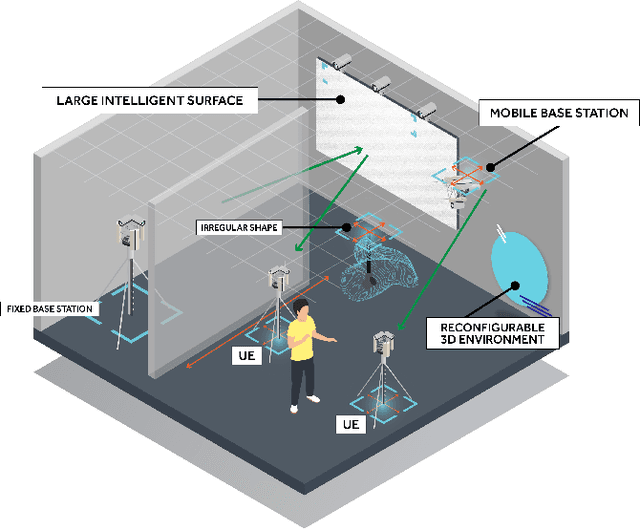
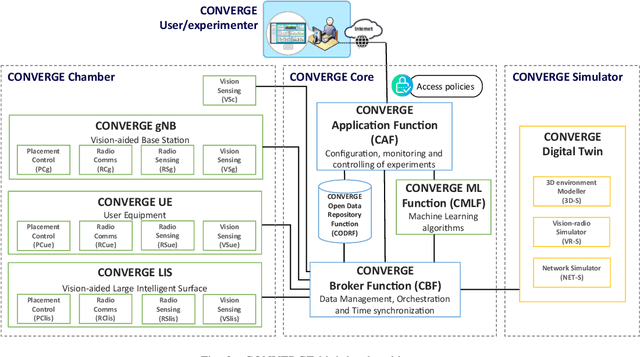
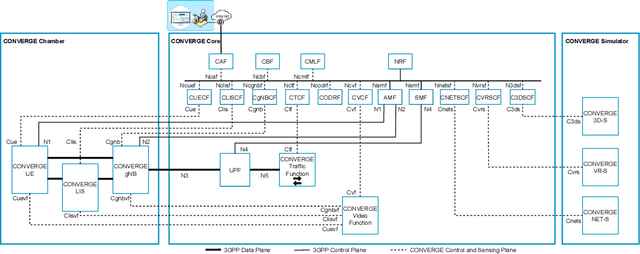
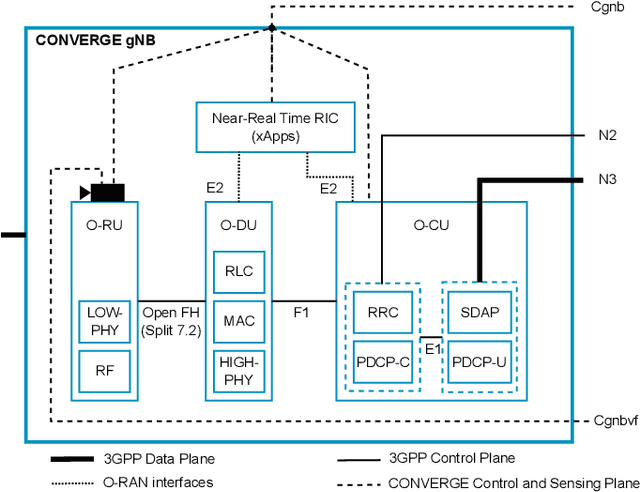
Abstract:Telecommunications and computer vision have evolved separately so far. Yet, with the shift to sub-terahertz (sub-THz) and terahertz (THz) radio communications, there is an opportunity to explore computer vision technologies together with radio communications, considering the dependency of both technologies on Line of Sight. The combination of radio sensing and computer vision can address challenges such as obstructions and poor lighting. Also, machine learning algorithms, capable of processing multimodal data, play a crucial role in deriving insights from raw and low-level sensing data, offering a new level of abstraction that can enhance various applications and use cases such as beamforming and terminal handovers. This paper introduces CONVERGE, a pioneering vision-radio paradigm that bridges this gap by leveraging Integrated Sensing and Communication (ISAC) to facilitate a dual "View-to-Communicate, Communicate-to-View" approach. CONVERGE offers tools that merge wireless communications and computer vision, establishing a novel Research Infrastructure (RI) that will be open to the scientific community and capable of providing open datasets. This new infrastructure will support future research in 6G and beyond concerning multiple verticals, such as telecommunications, automotive, manufacturing, media, and health.
Joint Traffic and Obstacle-aware UAV Positioning Algorithm for Aerial Networks
Jul 31, 2023Abstract:Unmanned Aerial Vehicles (UAVs) are increasingly used as cost-effective and flexible Wi-Fi Access Points (APs) and cellular Base Stations (BSs) to enhance Quality of Service (QoS). In disaster management scenarios, UAV-based networks provide on-demand wireless connectivity when traditional infrastructures fail. In obstacle-rich environments like urban areas, reliable high-capacity communications links depend on Line-of-Sight (LoS) availability, especially at higher frequencies. Positioning UAVs to consider obstacles and enable LoS communications represents a promising solution that requires further exploration and development. The main contribution of this paper is the Traffic- and Obstacle-aware UAV Positioning Algorithm (TOPA). TOPA takes into account the users' traffic demand and the need for LoS between the UAV and the ground users in the presence of obstacles. The network performance achieved when using TOPA was evaluated through ns-3 simulations. The results show up to 100% improvement in the aggregate throughput without compromising fairness.
On the Analysis of Computational Delays in Reinforcement Learning-based Rate Adaptation Algorithms
Mar 30, 2023Abstract:Several research works have applied Reinforcement Learning (RL) algorithms to solve the Rate Adaptation (RA) problem in Wi-Fi networks. The dynamic nature of the radio link requires the algorithms to be responsive to changes in link quality. Delays in the execution of the algorithm may be detrimental to its performance, which in turn may decrease network performance. This aspect has been overlooked in the state of the art. In this paper, we present an analysis of common computational delays in RL-based RA algorithms, and propose a methodology that may be applied to reduce these computational delays and increase the efficiency of this type of algorithms. We apply the proposed methodology to an existing RL-based RA algorithm. The obtained experimental results indicate a reduction of one order of magnitude in the execution time of the algorithm, improving its responsiveness to link quality changes.
UAV-Assisted Wireless Communications: An Experimental Analysis of Air-to-Ground and Ground-to-Air Channels in Open Environments
Mar 29, 2023Abstract:Unmanned Aerial Vehicles (UAVs) offer promising potential as communications node carriers, providing on-demand wireless connectivity to users. While existing literature presents various channel models, they often overlook the impact of UAV heading. This paper experimentally characterizes Air-to-Ground (A2G) and Ground-to-Air (G2A) wireless channels in obstacle-free, interference-free open environments, accounting for distance and UAV heading. We analyze the Received Signal Strength Indicator (RSSI) and TCP throughput between ground users and UAVs, covering distances between 50 m and 500 m, and considering different UAV headings. Our study offers a more accurate channel model characterization compared to deterministic models such as Friis and two-ray. Additionally, we characterize the antenna's radiation pattern based on UAV headings.
 Add to Chrome
Add to Chrome Add to Firefox
Add to Firefox Add to Edge
Add to Edge